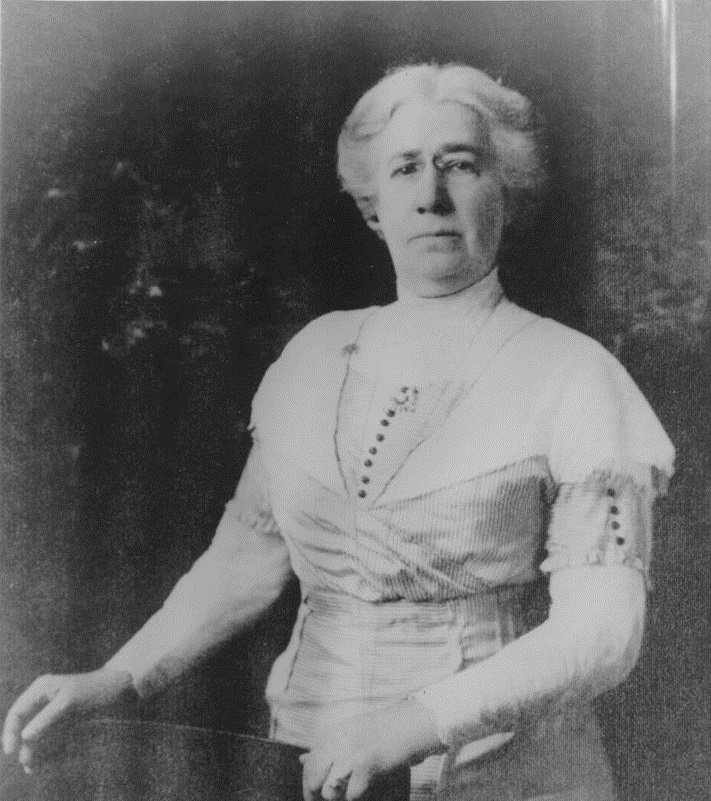Secrets of Chambers
On March 24, 1935, Annie Chambers, a former prostitute and Kansas City brothel owner, passed away at the age of 92. By the time of her death, Chambers' own life had neatly paralleled Kansas City's untamed years of the late nineteenth century that were followed by extensive reform efforts in the early twentieth century.

Born near Lexington, Kentucky, in 1842, her name was Leannah Loveall. The young Loveall encountered her first major tragedy when she estranged herself from her pro-Confederate father by participating in a parade honoring Abraham Lincoln. Shortly thereafter, she became a school teacher and married an older man named William Chambers. Unfortunately, the couple lost their first child, and then she unexpectedly entered a coma while she was expecting a second child. When Chambers awoke from her coma several months later, she learned that her husband had died in a horse and buggy accident. Magnifying these tragedies still further, her second pregnancy ended in stillbirth.
Distraught with grief, Leannah Chambers followed an acquaintance to Indianapolis and turned to a life of prostitution working under the name Annie Chambers. There she suffered raids by the Indianapolis police and fell into even deeper despair when her engagement to a former client ended with the discovery that the client was already married. After receiving advice from an acquaintance, Annie Chambers resolved to move to Kansas City, where she hoped that her "trade" would be better tolerated.
Kansas City proved to be the perfect home for Annie Chambers. In the 1870s the city's railroad hubs drew a diverse collection of businessmen, missionaries, railroad workers, cattlemen, and westward migrants. Young, unmarried men largely outnumbered women and frequented the 80 saloons and 40 houses of prostitution that catered to the bustling population of 50,000. The city, so hastily assembled in the short span of a decade, even lacked a formal police force until 1874.

For her part, Chambers demonstrated substantial business skills in the thriving city. She arrived in 1870 and opened a small brothel north of the Missouri River. Within two years she gained the resources to open an opulent 25-room mansion in the red-light district south of the river, in the City Market area. Operating within two blocks of City Hall, and later, Police Headquarters, the business quickly accumulated fame and made Chambers quite wealthy. A steady stream of bribes and fines protected Chambers' place from police interference.
Chambers reportedly took much pride in her work, as she believed that she provided a future for the destitute young women who came to work in her establishment. In her later years, she explained that many of the "thousands" of women who worked there found husbands and moved on to nobler pursuits of family life. While other local establishments charged as little as 25 cents for their services, her luxuriously appointed "resort," as she called it, charged up to $10, half of which the prostitutes kept. This could lead to incomes of $100 per week, a substantial sum for the time.
Despite her curious and enduring pride in her work, Chambers did eventually reform later in her life. She struggled to keep her business open after the maturing Kansas City attempted to clean up the red-light district starting in 1913. Nonetheless, Chambers finally relented in 1923 when the Reverend David B. Bulkley and his wife, Beulah Bulkley, inspired her to become a Christian.
Ironically, Chambers then spent the remaining decade of her life lecturing about the evils of sin while running her mansion as a legitimate boarding house. She never publicly denounced her own past, but the time had evidently come to help young women in more socially acceptable ways. After Chambers' death in 1935, the Bulkleys inherited the mansion and used it as part of their City Union Mission next door. After serving for nearly 75 years as a house of sin and then as a house of god, the mansion was finally razed in 1946.
Read a biographical sketch of Annie Chambers (1843-1935), prepared by Daniel Coleman for the Missouri Valley Special Collections, The Kansas City Public Library.
Check out the following books and articles about sin-city life in nineteenth-century Kansas City.
- Annie Chambers, by Lenore Carroll; a fictional novel inspired by Annie Chambers
- Voices Across Time: Profiles of Kansas City's Early Residents, by Dory DeAngelo; contains a chapter with more details about Annie Chambers, pp. 89-98
- The Other Missouri History: Populists, Prostitutes, and Regular Folk, Thomas M. Spencer
- Kansas City: An American Story, by Rick Montgomery and Shirl Kasper; contains a chapter entitled "Rowdy Times" about Kansas City in the late-nineteenth century with photographs, pp. 82-91
- "Annie Chambers' High-Toned Brothel," by Fred L. Lee, The Kansas City Genealogist, volume 38, number 2, 1997
- A Condensed History of the Kansas City Area: Its Mayors and Some V. I. P.s, by George Fuller Green; offers a brief profile of the City Union Mission, founded to "restore to decent living, derelicts such as alcoholics, bums and prostitutes," page 235
- "Gambling Halls, Saloons and Bawdy Houses," by Rudolph Umland in The Attic Window journal, volume 1, number 3, 1972; briefly profiles prominent establishments in Kansas City History
Continue researching Annie Chambers and the red-light district using archival material.
- Vertical File: Annie Chambers
- Vertical File: City Union Mission
- Charitable Organizations, Microfilm: Native Sons Scrapbooks, Roll 15; clippings about several charitable organizations and individuals
References:
Coleman, Daniel. "Biography of Annie Chambers (1843-1935), Madame," Missouri Valley Special Collections, 2007.
DeAngelo, Dory. Voices Across Time: Profiles of Kansas City's Early Residents. Kansas City, MO: Tapestry Publications, 1987.
Flynn, Jane Fifield. Kansas City Women of Independent Minds. Kansas City, MO: Fifield Publishing Co, 1992.
Montgomery, Rick and Shirl Kasper. Kansas City: An American Story. Kansas City, MO: Kansas City Star Books, 1999.


